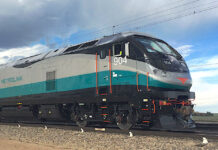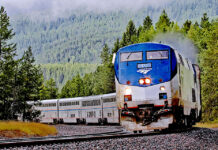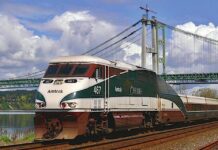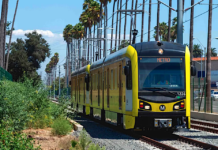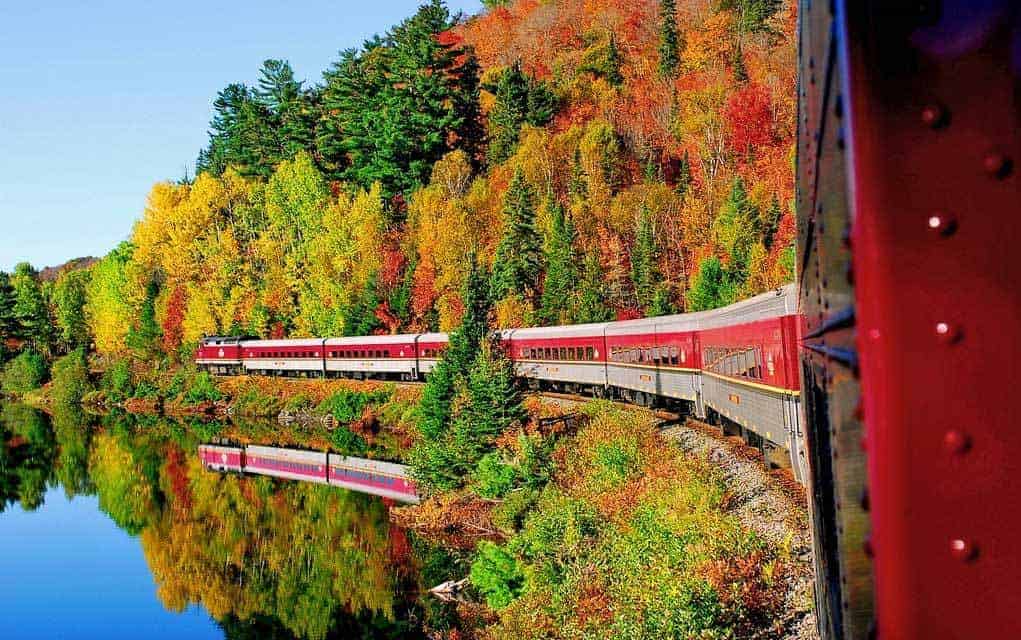
Hear the engines roar? Train journeys to the soul of Canada are ready to roll. Set your sights on the pioneer prairie. Catch a train to the heart of Cree Nation. Retrace the Group of Seven’s tracks. Crawl a wilderness strand tucked between mountains and sea.
Forget about the Rocky Mountaineer and The Ocean’s Maritime course. Come away instead aboard heritage trains that celebrate the rich history and rare beauty of Canada’s regions along scenic and historic stretches of the nation’s legacy railways. Some separated by thousands of kilometers, together they form a panorama of the rich rail heritage that helped to unite the Canadian Confederation.
So c’mon, catch the train! All aboard for four bucket-list journeys and the attractions along their ways! All four trains are restored and retrofitted to reimagine golden age Canadian rail travel with up-to-date additions like air conditioning, modern lavatories, and wheelchair access.
Train de Charlevoix

Train de Charlevoix
Québec City, Québec – La Malbaie, Québec
Phone: +1 (844) 737-3282
Twenty minutes northeast of Old Québec’s city walls, the Train de Charlevoix departs northward. For the next 125 km (80 mi), the train touristique clings to the St. Lawrence River’s North Shore, straddling a fine line where the river’s vast Atlantic tidal basin washes against the Canadian Shield’s rocky Laurentian face.
Cutting through the UNESCO-designated Charlevoix Biosphere Reserve, the train slips past remote river marshes and coves where seabirds call, beluga whale surge, and salt air permeates. The romantic journey links seven charming and historic outposts; including popular tourist destinations and wilderness access points.
Le train’s southern terminus is Québec City’s Montmorency Falls — Eastern Canada’s highest waterfall. Saint-Anne-de-Beaupré and its eponymous Roman Catholic basilica comes next. Petite-Rivière-Saint-François, Le Massif ski resort’s home town follows. A bit further along is Baie-Saint Paul, birthplace of both Cirque de Soleil and hockey cum donut king, Tim Horton. At last come the treasured villages of Les Éboulements and Saint-Irénée; and La Malbaie; le train’s northern terminus, heart of the Charlevoix, and site of 2018’s G7 conference.
Polar Bear Express

Polar Bear Express
Cochrane, Ontario – Mosonee, Ontario
Phone: +1 (800) 265-2356 ext. 2
Journey into the soul of Moose Cree Nation where roadways do not penetrate and beaten track is the lone lifeline. From Cochrane, Ontario — itself a remote settlement some 750 km (450 mi) due north from Toronto — it’s a five or six hour train ride across sodden muskeg bog land, through boreal spruce and tamarack wood, to Moosonee’s James Bay frontier and the Arctic watershed.
The Polar Bear Express is a misnomer, for there are no polar bear. But moose, caribou and eagles may be spotted along the way. Though lacking WiFi, the train is modern enough. Outfitted to haul all forms of freight; it can easily accommodate outdoor gear from rifles to snow mobiles to canoes. The buffet/bar car serves as social hub; a place where tourists and Cree Canadians nosh and nip while engaging in cross-cultural chat.
The Polar Bear Express’s destination is more indigenous settlement than tourist outpost. Moosonee’s remote and spare village is not for every traveler. It is for those drawn to endless skies of evening suns and Northern Lights; to seal chants and beluga wails.
Agawa Canyon Tour Train

Agawa Canyon Tour Train
Sault Ste, Marie, Ontario
Phone: +1 (800) 242-9287
Ever since Canada’s Group of Seven artists first rode a boxcar into Agawa Canyon, Algoma Country’s beauty has captivated generations of painters and outdoor lovers alike. Long home to the legendary Thunderbird spirit head of Ojibwe Nation lore, the canyon was accessible only by foot until Algoma Central Railway tracks were laid in the late 19th century.
The Agawa Canyon Tour Train retraces the same route. Its three-hour 180 km (110 mi) journey begins at the Soo — the provincial port of Sault Ste Marie just east of Lake Superior. Sparkling lakes and folds of rock-bound hills coax the train through mixed woodlands of birch, spruce, fir and maple. High trestle bridges reveal the sweeping Algoman paradise that inspired idyllic Group of Seven interpretations of wilderness hue and form. By late September, summer’s rich green palette swells to a fevered burst of crimsons, vermillions, and golds.
The Tour Train spends a two-hour layover in the granite-walled canyon. Time enough to climb 300-steps to Lookout Point, to marvel at the cascading waterfalls, or to settle into a quiet picnic spot and commune with nature.
Southern Prairie Railway

Southern Prairie Railway
Ogema, Saskatchewan
Phone: +1 (306) 459-7808
The rustling prairie grasslands sprawl just as when First Nations nomads and European settlers originally encountered them. Endless plains filled with endless possibilities beckoned travelers first on foot… then on horseback… and finally, in the early twentieth century, on trains. By the boom of the 1920s, anxious newcomers were most likely to first cross southern Saskatchewan by rail.
The Southern Prairie Railway recaptures the history and excitement. A true-to-life slice of Canadiana, its vintage 20th-century trainset cuts through the fertile fields of long grass that assured new arrivals of abundant harvests to come. Beneath Saskatchewan’s dome of living skies, the province’s outstretched prairie unwraps a rolling landscape of glacial-pushed dirt hills — formed by ice flows over ten thousand years ago. Sights along the route are simple: the steeple of a hamlet church, an ancient grain elevator, a century-old fairground, its timeworn wooden grandstand freshly painted.
Ogema itself gives the railway context. Prairie heritage is widely celebrated along the tiny town’s historic streets, in the town’s living history village, Deep South Pioneer Museum, and at the relocated lore-rich Canadian Pacific depot the Southern Prairie Railway now calls home.






